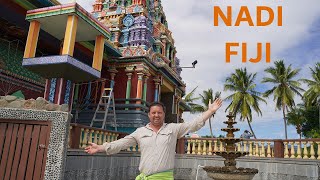
A day trip to Nadi, Fiji
August 27th, 2024

We were anchored in Musket Cove, waiting for a weather window to Vanuatu. We had enjoyed our time in Fiji but it was now time to move on. The winds were due to change direction, from a northerly to a southerly and we had decided to anchor in quite a enclosed space at Musket Cove where we had a reef on three sides of us. We didn't feel good about our decision to anchor there, but nonetheless, we did.

Heading to the sandbar on Tītī at Musket Cove
The change in wind direction happened at about 0900 hrs and brought with it quite a punch. We experienced 59.7 knots in the anchorage for a short period. This change in wind direction and wind strength caused us to drag anchor. We dragged about a boat length before the anchor reset itself and this put us now about half a boat length from the reef. This was not a good situation. We were able to reset the anchor in 30 knots of wind but it had us wondering, why are we dragging anchor when we have such a renowned anchor, a Rocna? It always seemed to happen when the wind direction changed and the strength was strong.

Vicki looking like a drowned rat after resetting the anchor in 30 knots of wind and heavy rain!
The only thing we could think of causing it was the self-correcting swivel we had attached to the anchor. The purpose of this swivel was to correct the anchor if it came up backwards (it swivels the anchor around) so that it can be placed into the bow roller. During our CAT1 inspection, the inspector had told us that these swivels were not recommended because they were considered a weak point. We put the issue to our Patreons, and one of our Patreons sent us the FAQ for Rocna, which clearly stated that these self-correcting swivels were not recommended for the Rocna anchors, they were considered unnecessary, and a weak point in the system. So, we have now removed it from the system and will continue to monitor the situation.
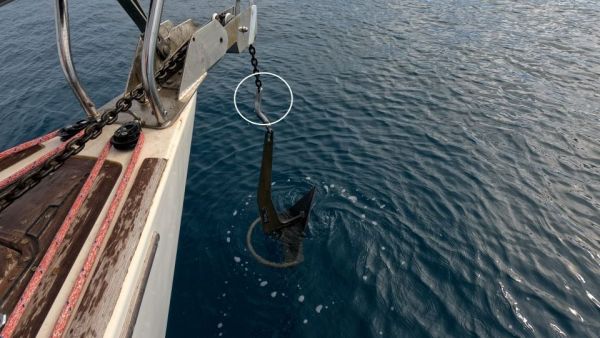
The self-correcting anchor swivel we think is delaying the anchor from resetting
Whilst in Vuda Marina we took the opportunity to explore Nadi. Nadi is a vibrant city. To avoid expensive taxi charges, we walked 3 km from Vuda Marina to Viseisei Village. We have since learned there is a tram track that you can take from the marina to Viseisei Village and it is more direct and safer from vehicles. We have walked the tram track and it was a lot better, shorter, and was a nicer walk.

The tram track that leads from Vuda Marina to Viseivei Village
The ViseiseiVillage is considered to be the place where the first landing of the Fijian people occurred. You can do a tour of the village. It cost us $10 Fijian dollars (FJD$) each and a guide will take you around the village. It was a short tour. Women have to wear a sula to walk around the village. It is well worth a visit and the guide explains the history of the village and the people.

We loved this sign showing that Viseisei had a back road!
Opposite Viseisei Village is a bus stop which goes to Nadi and Latoka. For the both of us, the cost of the bus was FJD$5.50 which is a lot cheaper than the FJD$60 taxi (one way) from Vuda Marina. Catching the bus was a great experience and a good way to see the landscape. We hopped off the bus at the market and walked to the Sri Siva Subramaniya Temple and is said to be the largest Hindu temple in the Southern Hemisphere. It's open to both worshippers and tourists but there dedicated areas for worshippers only. As a tourist, the charge to visit the temple was FJD$5 each.
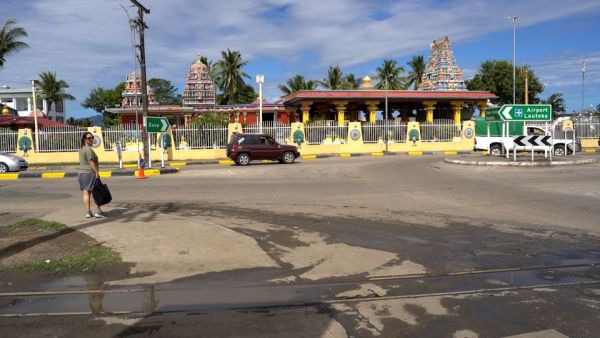
Walking to the Sri Siva Subramaniya Temple Nadi, Fiji
The devotion of the people worshipping was incredible to see. People were walking around the temple, with some doing many laps of the temple holding a plate of fruit consisting of half a coconut and two bananas. This fruit is blessed by a Priest, and then offered to the Hindu Gods. There is a main temple and surrounding this temple are smaller buildings. We were told that the smaller buildings are for the different Hindu Gods which the worshippers also stop and ask for a blessing. It's a busy place but very peaceful at the same time.
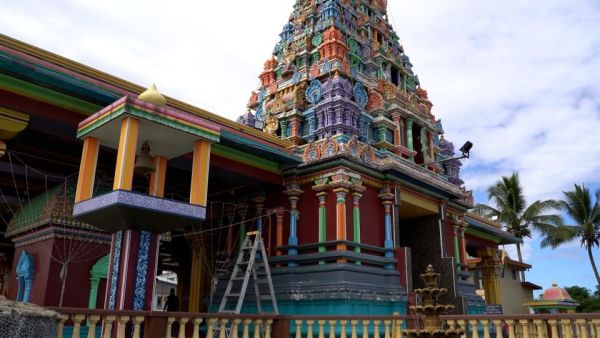
View of the Sri Siva Subramaniya Temple in Nadi, Fiji
From the temple, it is an easy walk back to the market. The Nadi market is quite large and has a variety of fruit and vegetables on offer. Much of the vendors do sell the same thing but some vendors have a few extras like spring onions and coriander (cilantro) which is always a treat when the access to food and our diet is quite limited in these places. The market is very cheap and you can get food at very reasonable prices. For example, we bought 5 Lebanese cucumbers for FJD$2. Initially tomatoes were not in season when we first arrived in Fiji and so were quite expensive for a few tomatoes and they were very small. They came into season about August and then were really cheap. We could buy about 6 tomatoes for FJD$3.
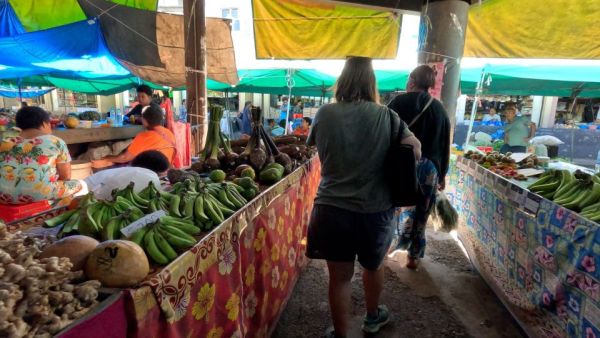
Nadi market is large and offers a variety of fresh fruit and vegetables which are reasonably priced
Catching a taxi from the market is very easy and there's a lot of them driving around looking to pick people up. We tended to catch a taxi back to the marina because it was easier to load all our provisioning into a taxi rather than take it back on a bus. Also, the taxis will stop at other shops for you and wait while you buy more stuff. On the two occasions we took a taxi from the market back to Vuda Village, we stopped at two other shops and the total cost of the taxis was FJD$30. We didn't think this was too bad.
If you enjoy our videos and posts, please consider subscribing to our YouTube channel here.
If you'd like to support the making of these videos and posts, hop over to Patreon and join the crew here.